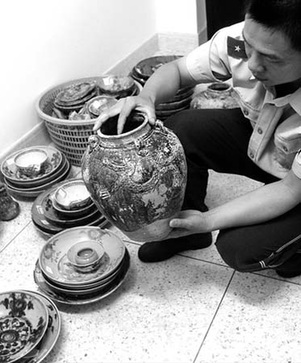-
News >China
Relics to be salvaged from ancient ship
2010-04-09 08:19GUANGZHOU - The salvage of relics from a sunken ancient merchant vessel has resumed after six months of suspension in Shantou, a coastal city in South China's Guangdong province.
Cui Yong, captain of the Guangdong marine archaeological group, said on Thursday that his group is ready to restart the salvage work of the Nan'ao No 1, a vessel that sank in the late Ming Dynasty (1368-1644) in the South China Sea.
"Currently, the only permission we are waiting for is from the weather," Cui said.
A police officer displays the pottery and porcelain artifacts salvaged from the sunken ancient merchant ship Nan'ao No 1 on June 8, 2007. [Xinhua]
More than 10,000 pieces of antique porcelain are expected to be salvaged from the sunken vessel in three months, if everything goes smoothly.
The three month period, from April to June, is usually the best time to salvage sunken vessels, as typhoons and other tropical storms have yet to hit the Chinese coast, Cui said.
Xin Guoan, director of the relics department under the Shantou bureau of culture, said only relics from the vessel will be salvaged. In 2007, another high-profile ancient sunken vessel, Nanhai No 1, was lifted entirely from the sea near Yangjiang of Guangdong.
The wooden hull of Nan'ao No 1, which sank more than 400 years ago, had been seriously damaged, Xin said.
Nan'ao No 1, a merchant vessel dating from the Ming Dynasty, carried more than 10,000 pieces of porcelain when it sank in east Guangdong waters. The vessel is 28 meters long and 10 meters wide.
Archaeologists from Guangdong have determined most of the porcelain on the vessel was made in east Guangdong, south Fujian and Jiangxi provinces, according to an examination of the 200 pieces salvaged last year.
Nan'ao No 1 was first found in 2007. The salvage of the sunken vessel was begun at the end of last year, but the operation had to be delayed because of bad weather.
The relics on the vessel are valuable for the study of ancient porcelain production technologies, the country's ancient ocean trade and the ancient "Marine Silk Road" - China's southern passageway to the outside world, archaeologists said.
Archaeologists have estimated that waters in Guangdong and the surrounding area - the starting point of the "Marine Silk Road" - may hold more than 1,000 sunken ancient vessels, which, experts believe, indicates the province was a commercial and trading hub since ancient times.
Last December, a marine museum, which mainly exhibits the relics salvaged from Nanhai No 1, was completed and opened to the public in the city of Yangjiang.
Located on Yangjiang's Hailing Island, construction of the museum, which covers an area of 12,200 square meters, cost more than 200 million yuan ($29.28 million).
In addition to the relics from Nanhai No 1, the 30-meter long wooden vessel has been placed inside a "crystal palace" made of glass at the museum.
